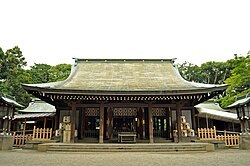Hikawa Shrine (Saitama)
| Hikawa Shrine | |
|---|---|
 |
|
| Information | |
| Type |
Shikinaisya Musashi no Kuni ichinomiya or sannomiya Former kanpeitaisha Chokusaisha Beppyo jinja |
| Dedicated to |
Susanoo Kushinadahime Ōkuninushi |
| Founded | 473 BC |
| Founder(s) | Emperor Kōshō |
| Reisai | Reitaisai (Annual main festival) (August 1) |
| Honden style | Nagare-zukuri |
| Address | 1-407, Takahana-cho, Omiya-ku, Saitama-shi, Saitama, Japan |
| Website | musashiichinomiya-hikawa |
|
|
|
Hikawa Shrine (氷川神社 Hikawa-jinja?) is a Japanese Shinto shrine in Omiya-ku, Saitama, Saitama Prefecture. Surrounding the shrine is a large park in which there are many cherry blossom trees, a zoo and a museum.
The district of Omiya, literally "Great Shrine", derives from the special favor shown by Emperor Meiji, who raised Hikawa above all other shrines in the Kantō region.
Standing behind three torii gates in a wood with many ancient Japanese elms, it claims to have a 2400-year history.
According to the shrine's tradition, the shrine was established during the reign of Emperor Kōshō in 473 BC. A legend recounts that Yamato Takeru, who injured his leg during his crusade to the East, visited the shrine in accordance with the directions of an old man who appeared in a dream. After worshiping, he was able to stand on his own. It is known that the old name of the region, Ashidate (足立?), literally meaning "leg stand", was named after this incidence. The pond within the grounds of the shrine is a remnant of Minuma and considered to have roots in enshrining the water god of Minuma.
Hikawa was designated as the chief Shinto shrine (ichinomiya) for the former Musashi province. This main shrine has 59 branch shrines in Tokyo and 162 branch shrines in Saitama Prefecture.
...
Wikipedia
